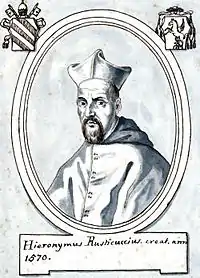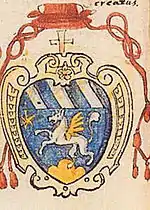Girolamo Rusticucci
Girolamo Rusticucci (1537 – 14 June 1603) was an Italian Roman Catholic cardinal and bishop. He was personal secretary to Cardinal Michele Ghislieri, later Pope Pius V, who made Rusticucci a cardinal. He occupied numerous important positions, including papal legate to France and Spain, Camerlengo (treasurer) and Vice-Dean of the College of Cardinals, and Vicar General of Rome.


He built a palace near Saint Peter's Square in Rome, located on a new piazza that was named after the cardinal.
Biography
Girolamo Rusticucci was born in Cartoceto in 1537, the son of Ludovico Rusticucci, a famous jurisconsult, and his wife Diamante Leonardi.[1] He was orphaned as a young man.[1] As a young man, he studied literature and oratory.[1]
Rusticucci traveled to Rome in 1557, entering the court of Cardinal Michele Ghislieri, who later became Pope Pius V, as the cardinal's personal secretary.[1] When the cardinal became pope, he made Rusticucci a protonotary apostolic.[1] Also, when Cardinal Michele Bonelli, Pope Pius V's cardinal-nephew, was absent, the pope put Rusticucci in charge of managing most of the church's affairs.[1]
Pope Pius V made him a cardinal priest in the consistory of 17 May 1570.[1] He received the red hat and the titular church of Santa Susanna on 9 June 1570.[1]
On 16 June 1570 he was elected Bishop of Senigallia.[1] He was consecrated as a bishop in the Sistine Chapel by Cardinal Marcantonio Maffei with Francesco Rusticucci, Bishop of Fano, and Giuseppe Pamphilj, Bishop of Segni, serving as co-consecrators.[1] As a bishop, he promoted educating his clergy along the lines provided by the Council of Trent.[1] He resigned the government of the diocese sometime before 29 November 1577.[1]
Pope Pius V then named him papal legate to Spain and the Kingdom of France to promote war against the Ottoman Empire.[1] He participated in the papal conclave of 1572 that elected Pope Gregory XIII, and in the papal conclave of 1585 that elected Pope Sixtus V.[1] He served as Vicar General of Rome from 1588 to 1603.[1] He was also a participant in the papal conclave of September 1590 that elected Pope Urban VII; the papal conclave of October–December 1590 that elected Pope Gregory XIV; and the papal conclave of 1591 that elected Pope Innocent IX.[1] He became Camerlengo of the Sacred College of Cardinals on 8 January 1590 and was confirmed in the post on 14 February 1592.[1] He participated in the papal conclave of 1592 that elected Pope Clement VIII.[1] The new pope confirmed him as Camerlengo of the Sacred College of Cardinals, and he held that position from 14 February 1592 to 1593.[1]
On 18 August 1597 he opted for the titular church of Santa Maria in Trastevere.[1] Soon thereafter, he became the cardinal protopriest.[1] He opted for the order of cardinal bishops on 30 March 1598, taking the Suburbicarian Diocese of Albano.[1] He opted for the Suburbicarian Diocese of Sabina on 21 February 1600 and then for the Suburbicarian Diocese of Porto e Santa Rufina on 19 February 1603.[1] He was the Vice-Dean of the College of Cardinals.[1]
He died in Rome on 14 June 1603.[1] He was buried in Santa Susanna.[1]
Palazzo Rusticucci-Accoramboni
In 1584 Rusticucci, after having bought a lesser palace and several houses at the west end of Via Alessandrina in Borgo, gave to Domenico Fontana the task to build a new palace there, the Palazzo Rusticucci-Accoramboni.[2] The work was finished by Fontana`s nephew, Carlo Maderno.[3] After the work for the erection of Saint Peter's Square, the palace occupied the north side of a new piazza, Piazza Rusticucci, which was named after the cardinal.[3]
Sources
References
| Wikimedia Commons has media related to Girolamo Rusticucci. |
- Entry from Biographical Dictionary of the Cardinals of the Holy Roman Church
- Gigli (1992) p. 86
- Gigli (1992) p. 88